This Mediterranean classic is a staple in many Greek households, including mine. It features layers of tender eggplant, thinly sliced potatoes, a rich tomato meat sauce, and topped with a creamy béchamel sauce. Baked to golden perfection, it is a comforting and flavourful meal that I am sure you and your family will love.
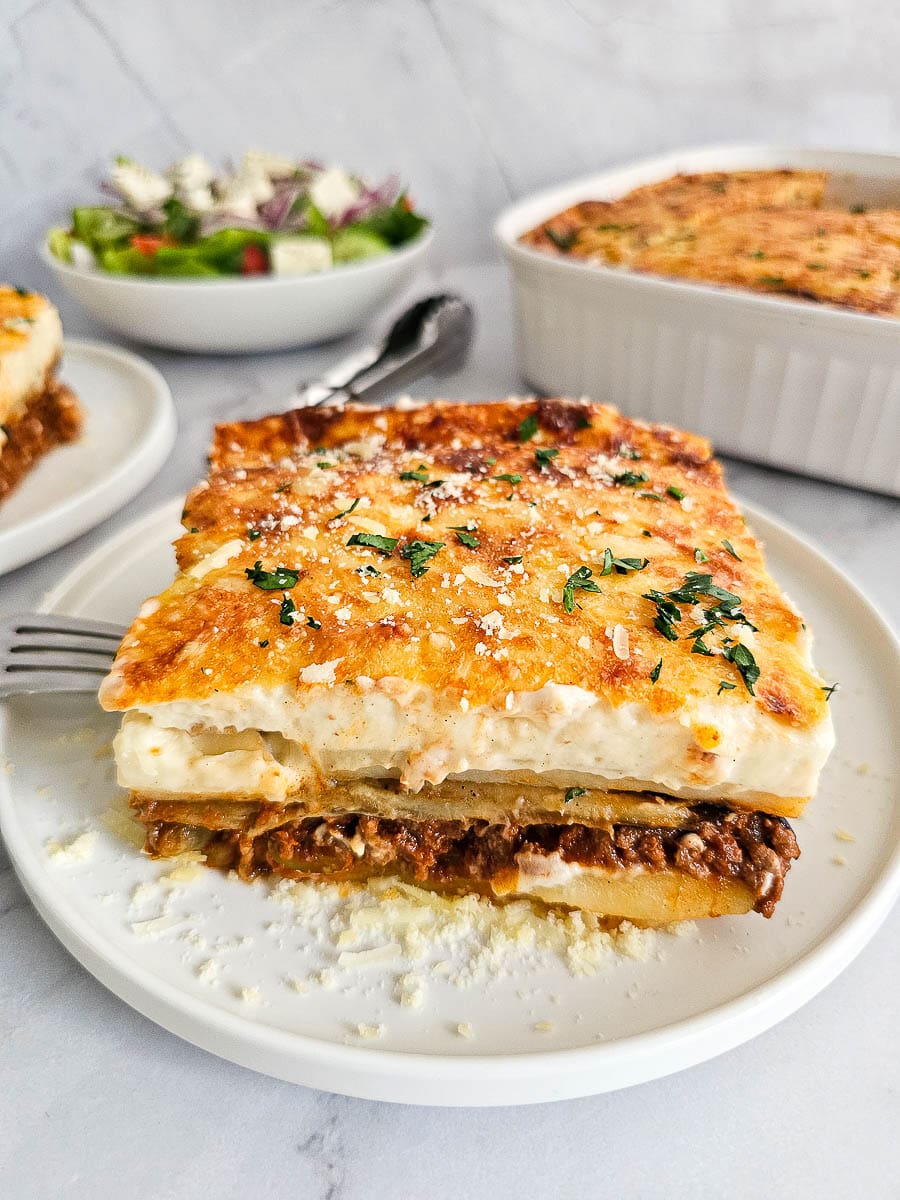
This Greek Moussaka recipe, passed down from my mum and aunt, starts with a layer of thinly sliced, shallow-fried potatoes. It is then topped with a layer of eggplant, traditionally shallow-fried, but you can choose to bake the eggplant if you prefer. Occasionally, they add a few slices of zucchini, followed by a rich tomato meat sauce made with beef mince, though you can use lamb mince if you prefer. Finally, it is generously topped with béchamel sauce and then sprinkled with grated cheese.
Although there are many variations to the Moussaka recipe, with differences in the choice of meat, inclusion of potatoes or zucchini, whether to bake or fry the eggplant and potatoes and various layering techniques, I believe Moussaka is a dish you can’t go wrong with. Whatever ingredients you decide to add or omit, it is a flavourful dish that I am sure you will add to your recipe collection.
I must confess, it does take a bit of time to prepare and requires a hands-on approach, but to simplify, I have included some make-ahead tips below. Moussaka is best served warm. After baking, allow it to rest for 20-30 minutes so it is easier to slice. Serve it with a Greek Salad or Greek Lettuce Salad – Maroulosalata, to balance the richness of the dish.
A brief history of Greek Moussaka
Although a lot of people associate Moussaka as a Greek dish, the origins of Moussaka can be traced back to the Middle East, where similar dishes with layered vegetables and meat were popular. Arab immigrants later introduced their version of this dish to Greece and Turkey. But it was Nikolaos Tselementes, a renowned Greek chef, influenced by his French culinary education, who transformed the Greek version of Moussaka to what we know it today. He introduced the rich, creamy béchamel sauce that has since become an integral part of the dish today.
How to make Moussaka (Minced Beef, Eggplant and Potato Bake)
While it does take some time to prepare, it is well worth the effort! Each step contributes to the rich layers of flavours in this traditional Greek Moussaka.
There are four different components to this traditional Greek Moussaka:
- Shallow frying the potatoes,
- Baking the eggplant,
- Preparing the meat sauce, and
- Preparing the béchamel sauce.
Moussaka ingredients
Ingredients for the vegetable layers

- Eggplant: Traditionally, shallow fried in olive oil. However, to make the dish lighter, I have baked the eggplant. My mum sometimes adds a couple of white zucchinis/courgettes with the eggplant layer.
- Potatoes: I shallow fry them but you can bake the sliced potatoes if you prefer.
How to prepare the vegetables for Moussaka
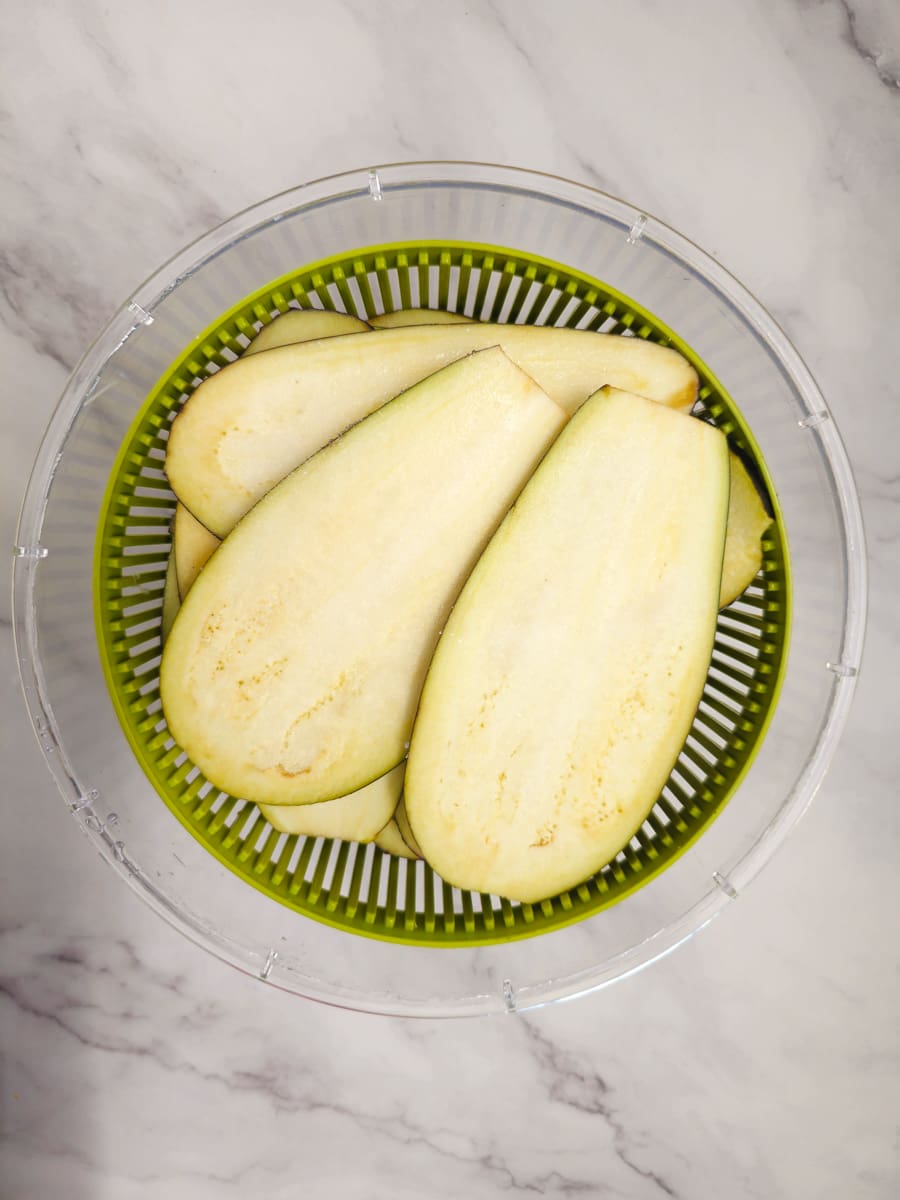
1. Slice eggplants lengthways. Place eggplant in colander and sprinkle generously with salt. Let them sweat for about 30 minutes. Meanwhile, prepare the meat sauce. Rinse and pat dry the eggplant with a clean tea-towel.
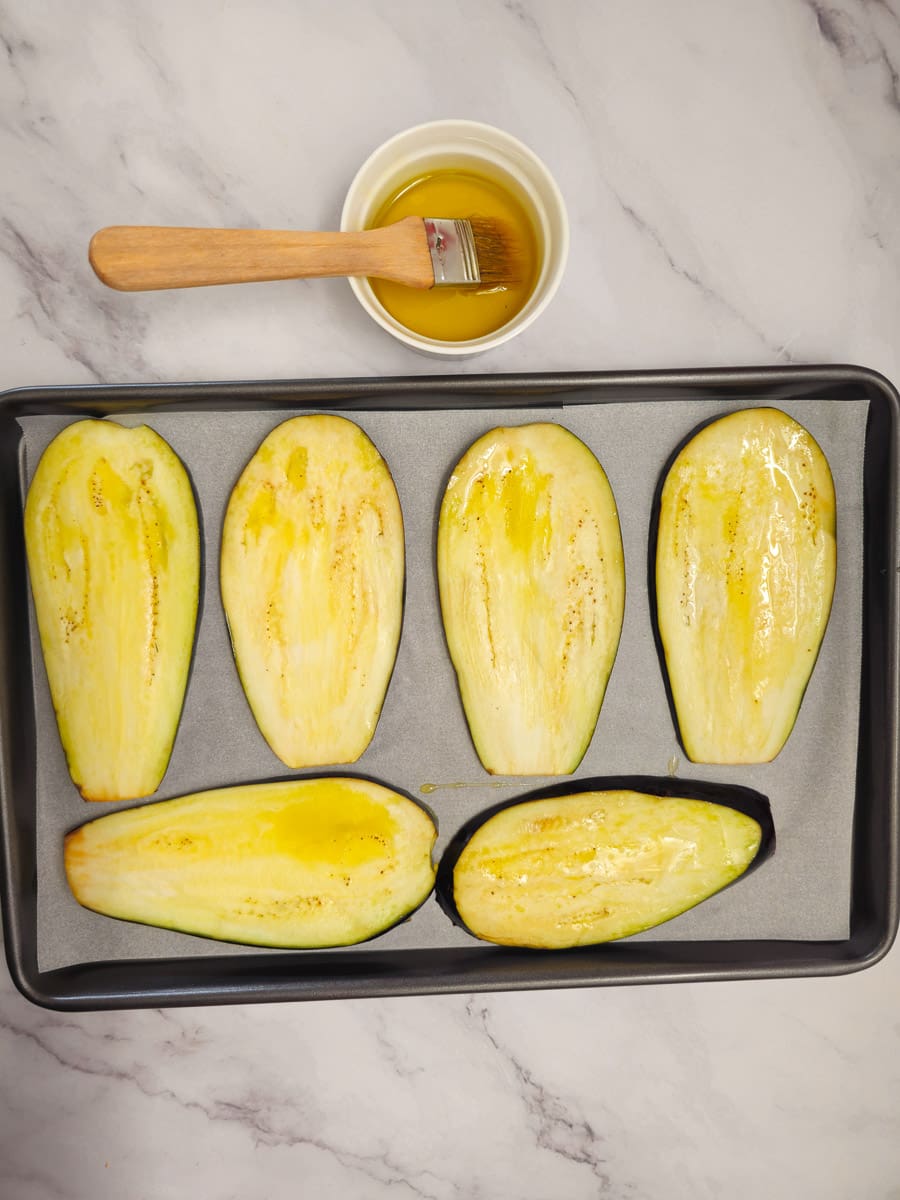
2. Arrange sliced eggplant in a single layer, on baking tray lined with baking paper. Lightly brush them with oil on both sides and sprinkle with salt and pepper.
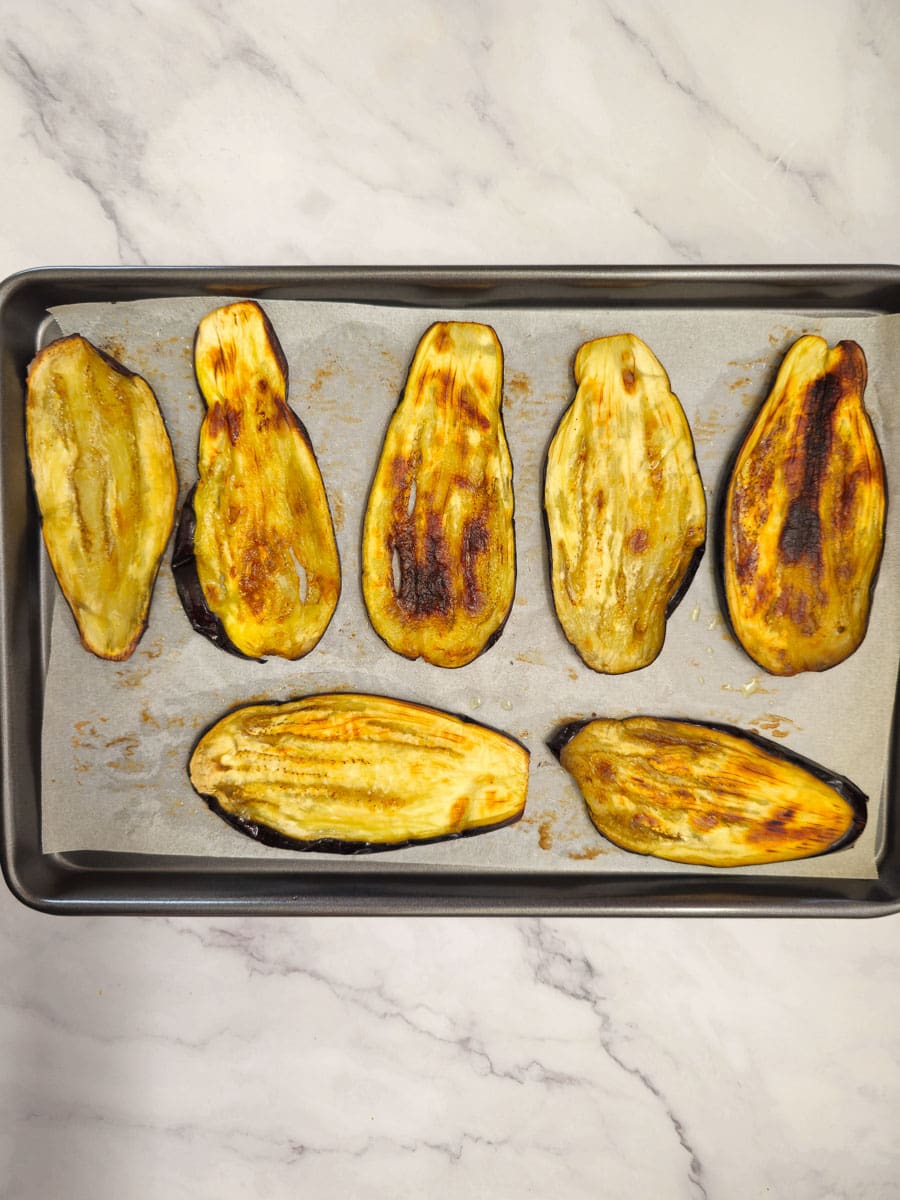
3. Bake eggplant in oven for 15 minutes, then flip the slices over and continue baking for another 10-15 minutes or until lightly browned and eggplants are soft when pressed.
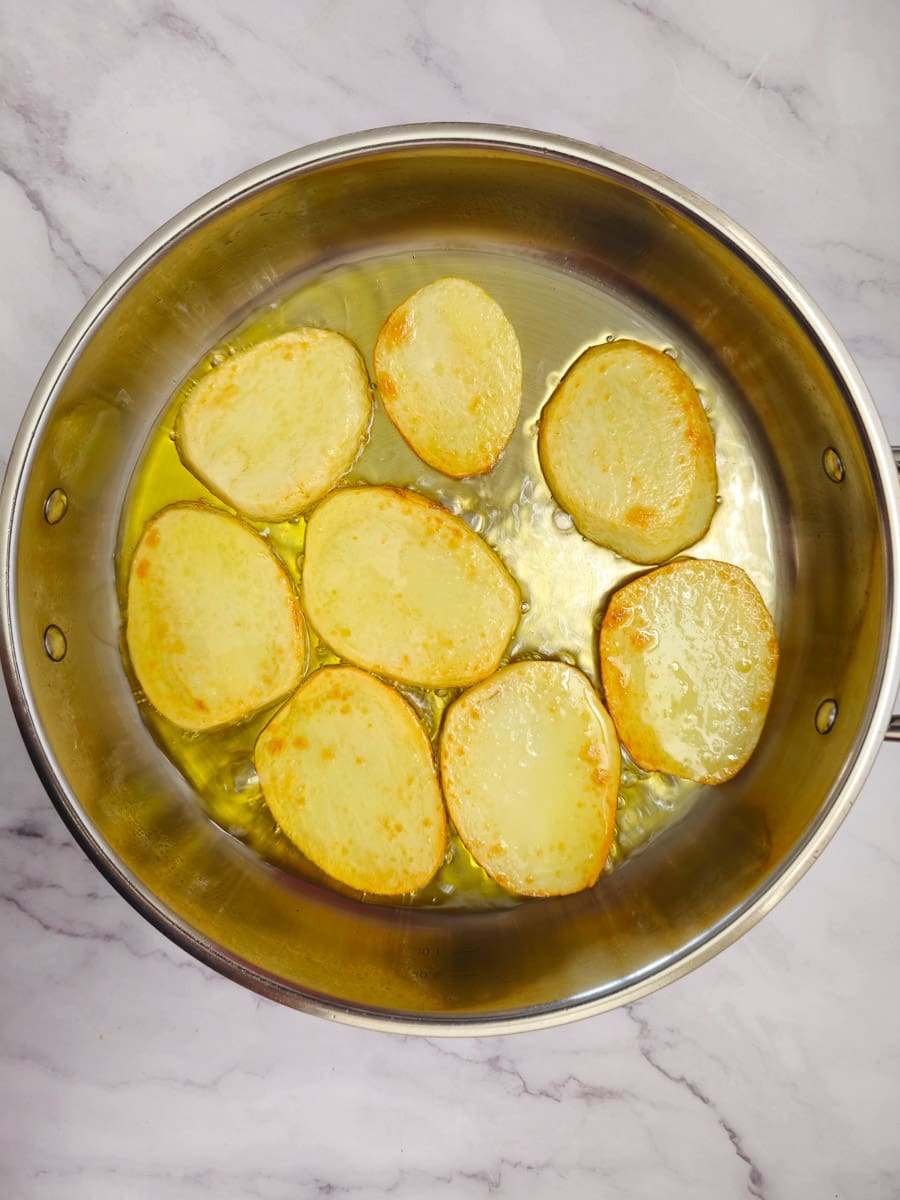
4. Meanwhile, peel and slice potatoes. Shallow fry potatoes, in batches, until cooked through and lightly golden on both sides. Place on a plate lined with a paper towel.
Ingredients for the meat sauce
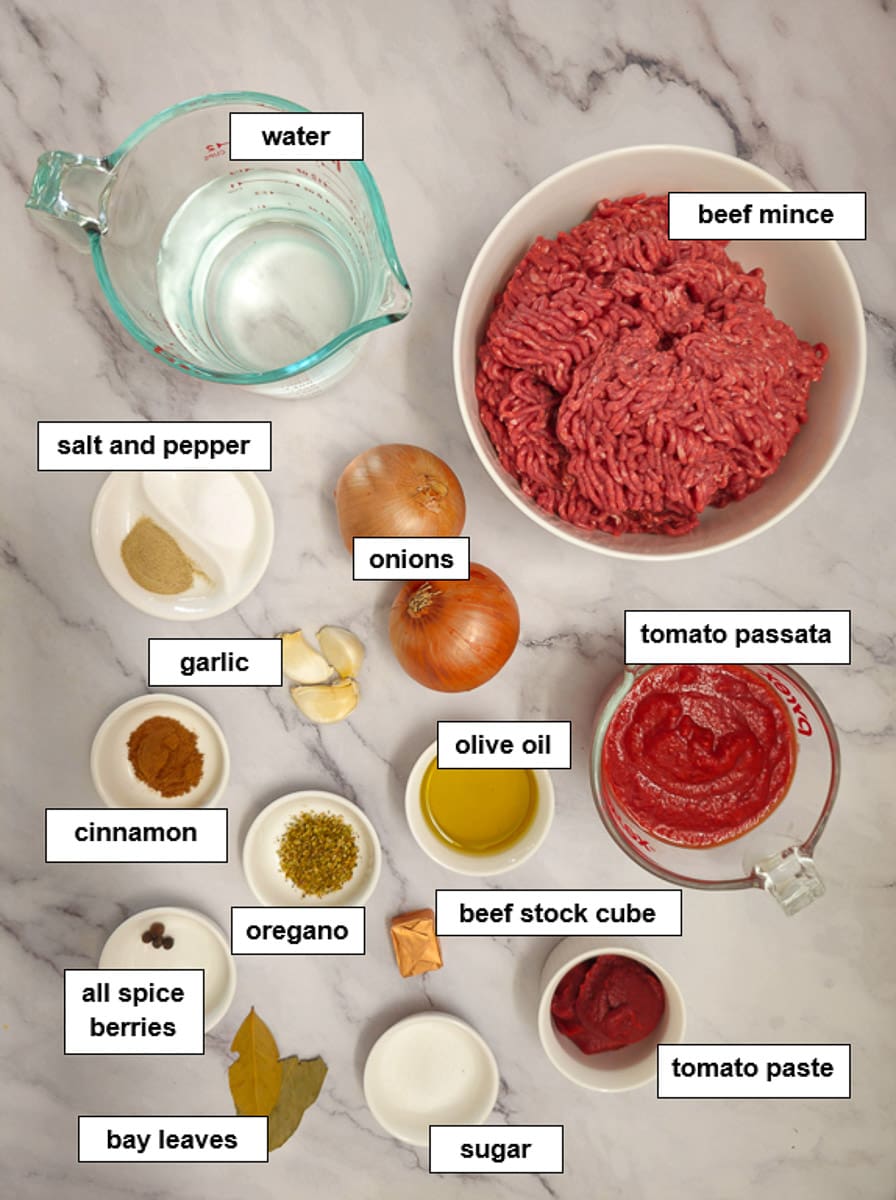
- Beef mince: You can use beef or lamb mince when making Moussaka, whatever you prefer. I use lean beef mince because it contains less fat, resulting in a dish that is less oily and greasy.
- Tomato paste and tomato puree/passata: You can use either canned or jarred tomato paste and puree, depending on availability and personal preference.
- Spices/herbs: The combination of cinnamon, allspice, oregano and bay leaves gives a distinctive Mediterranean flavour profile to the meat sauce. I find allspice berries in delicatessens. You can substitute for ground allspice.
How to make the meat sauce
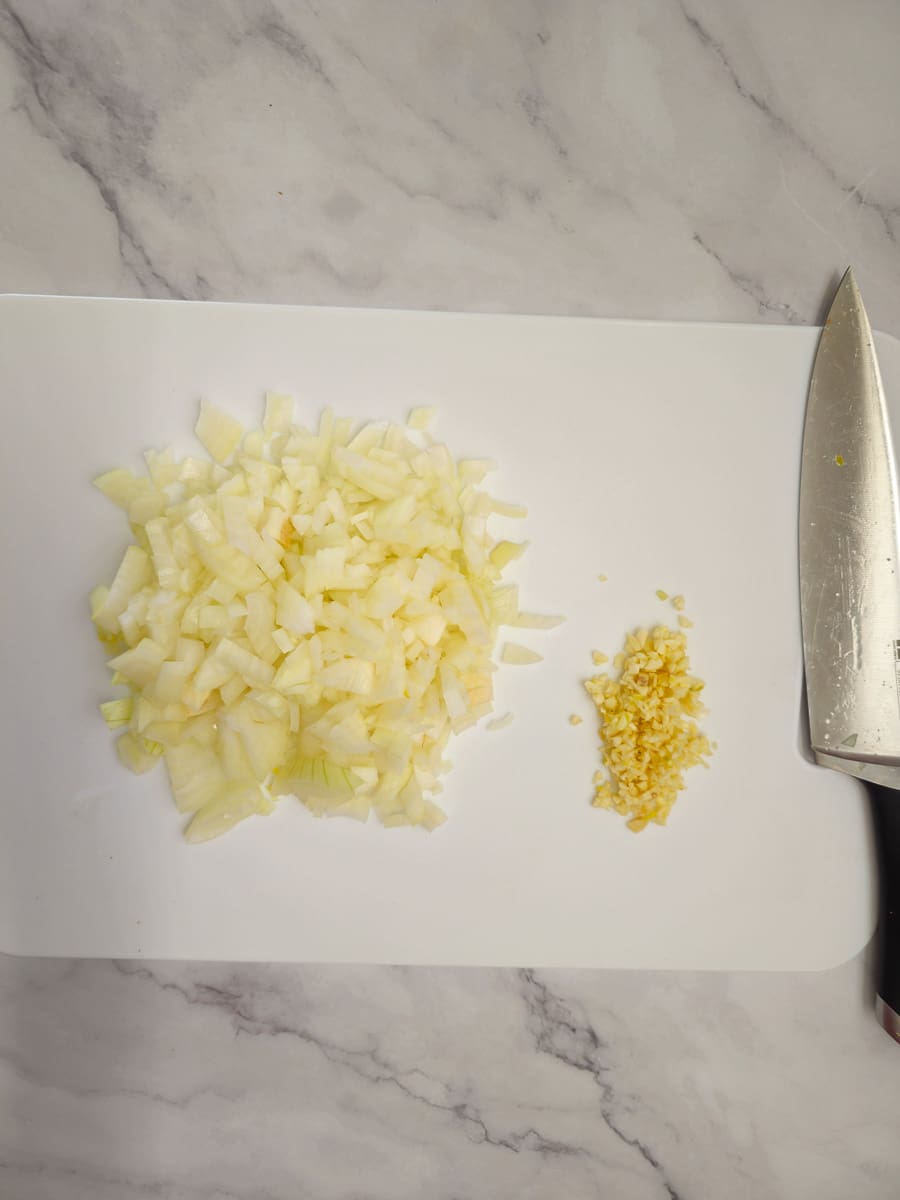
1. Dice onions and mince garlic.
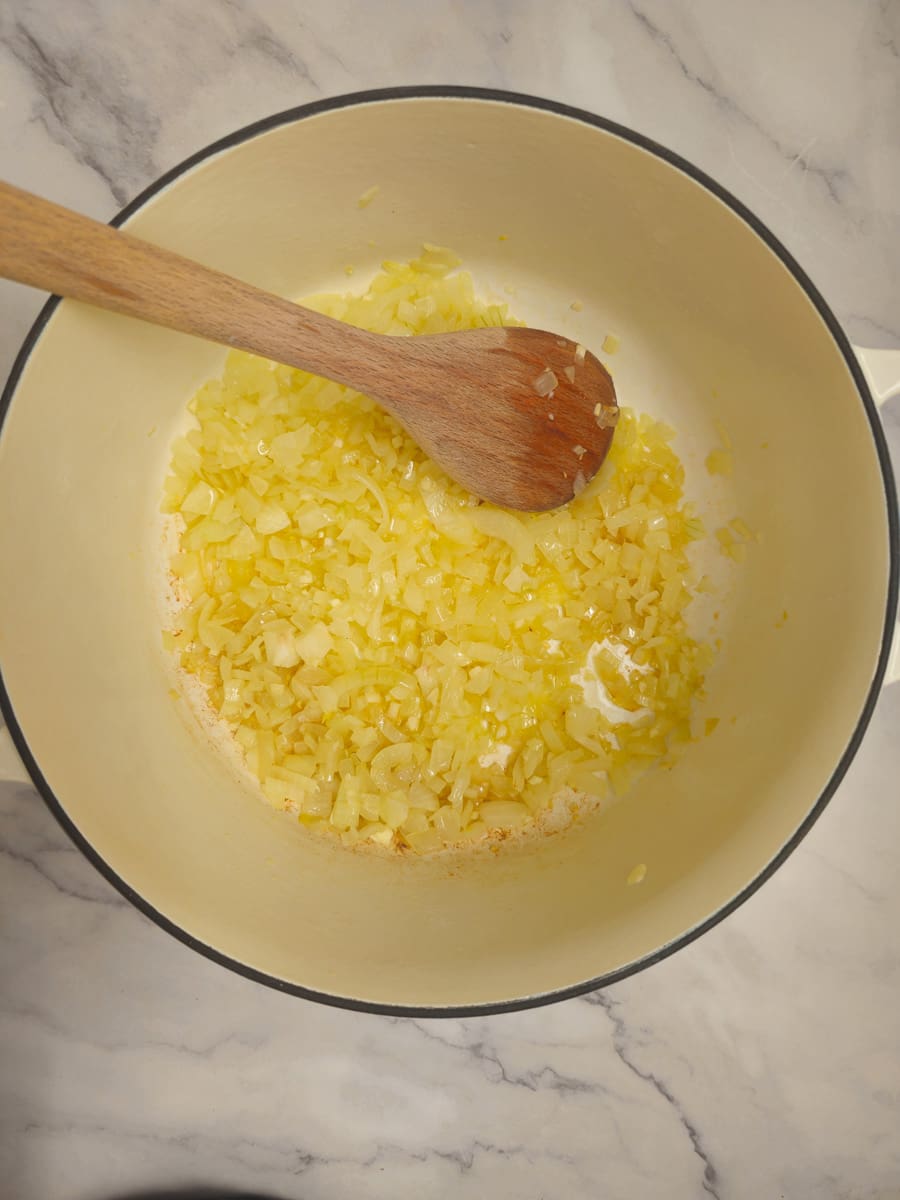
2. Heat oil in saucepan. Add onion and sauté for 2-3 minutes over medium-high heat until the onion is soft. Add the garlic and continue to sauté for 1-2 minutes.
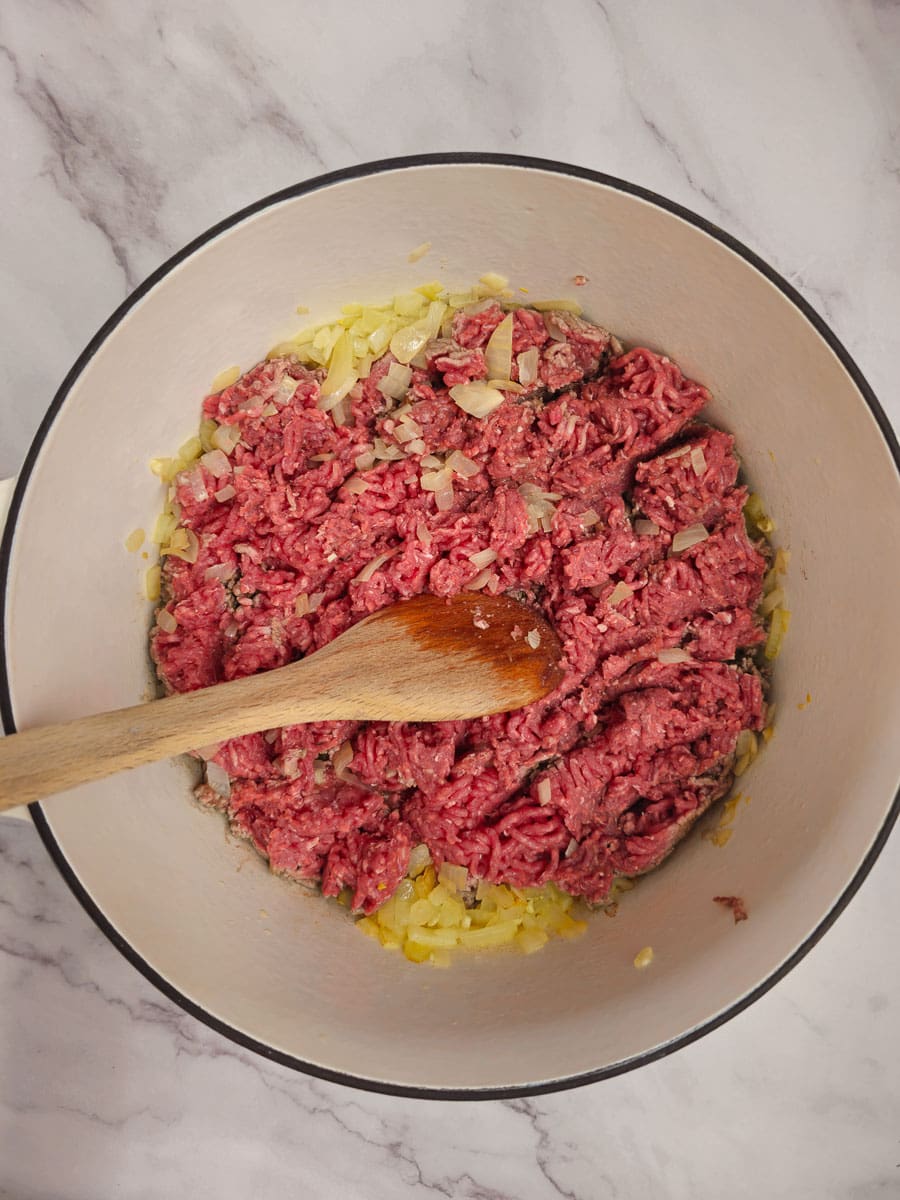
3. Add the beef mince and cook over high heat for 5-6 minutes until browned, using a wooden spoon to break the mince into smaller pieces as it cooks.
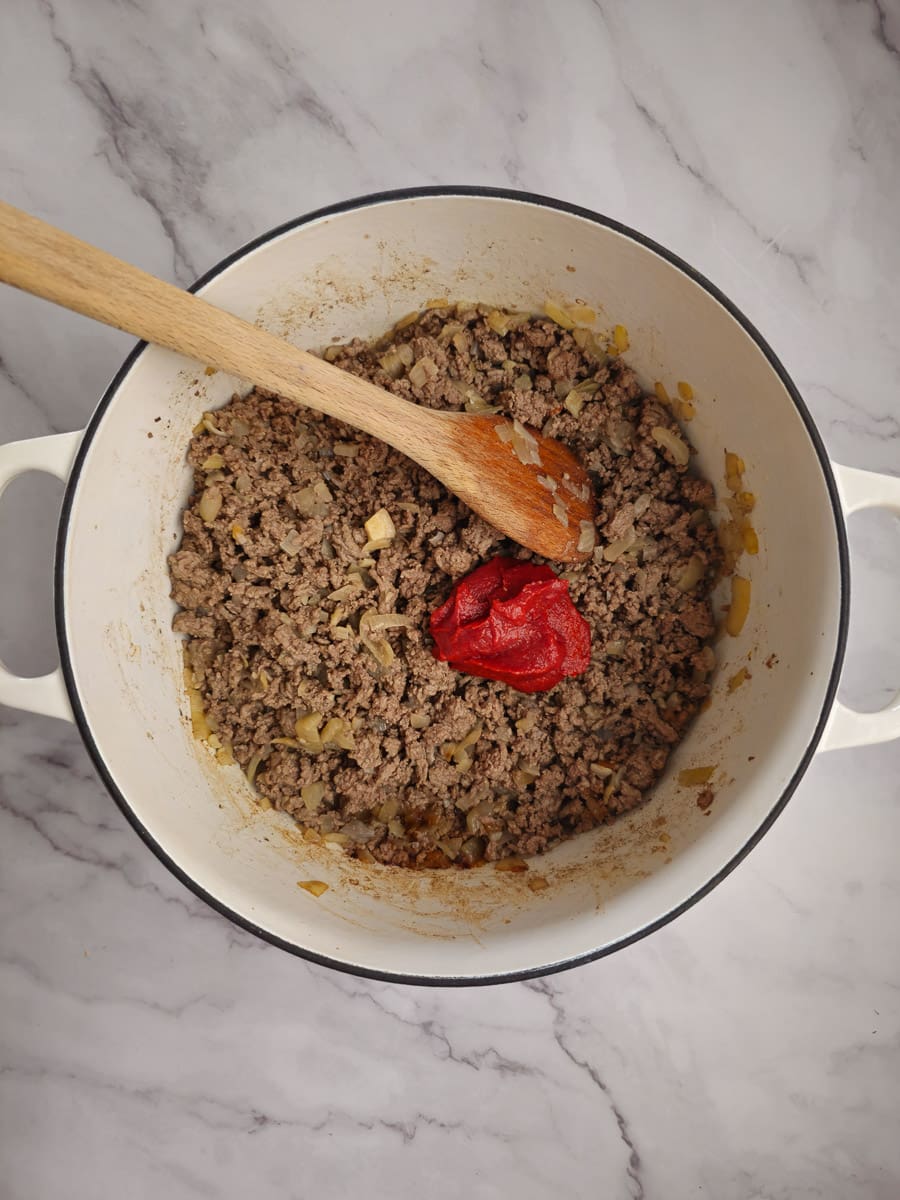
4. Add the tomato paste and cook for 2 minutes.
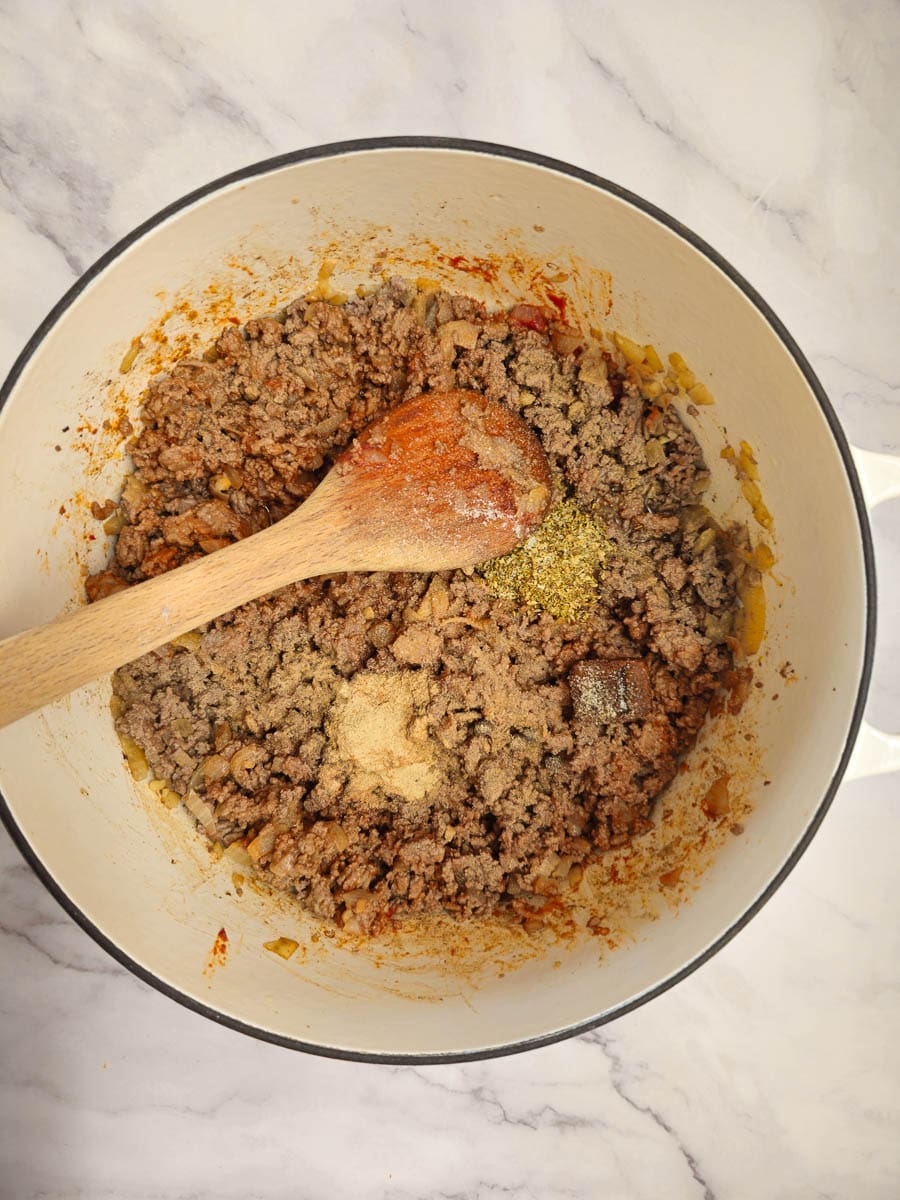
5. Add cinnamon, pimento berries, oregano, beef stock cube, salt and pepper. Stir for about 1 minute.
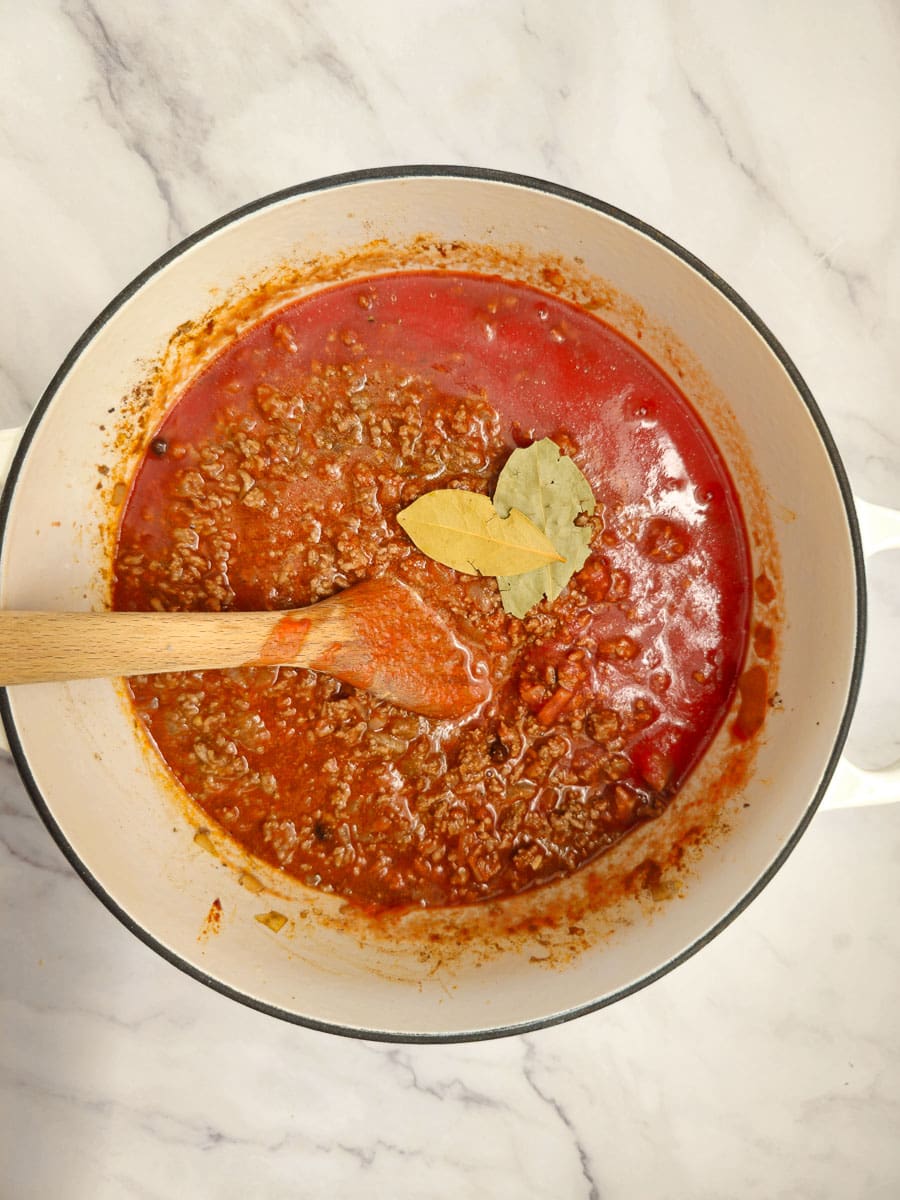
6. Add tomato puree, sugar, bay leaves and water. Bring to boil and then reduce heat to medium-low so it is simmering gently.

7. Cover and simmer for approximately 40- 45 minutes, stirring occasionally, until most of the water has evaporated. Meanwhile, prepare eggplant and potatoes.
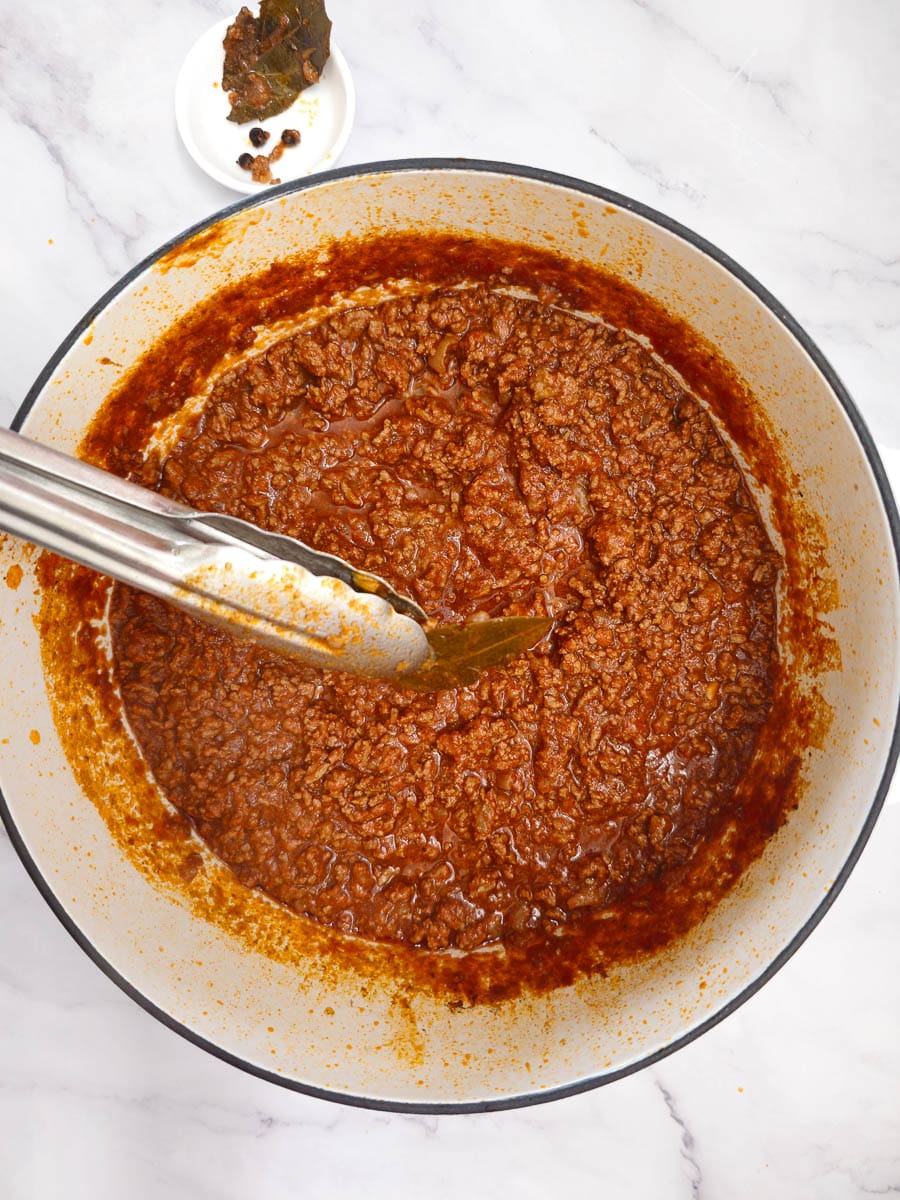
8. Remove from heat and remove lid. Cool slightly. Remove bay leaves and pimento berries.
Ingredients for the béchamel sauce
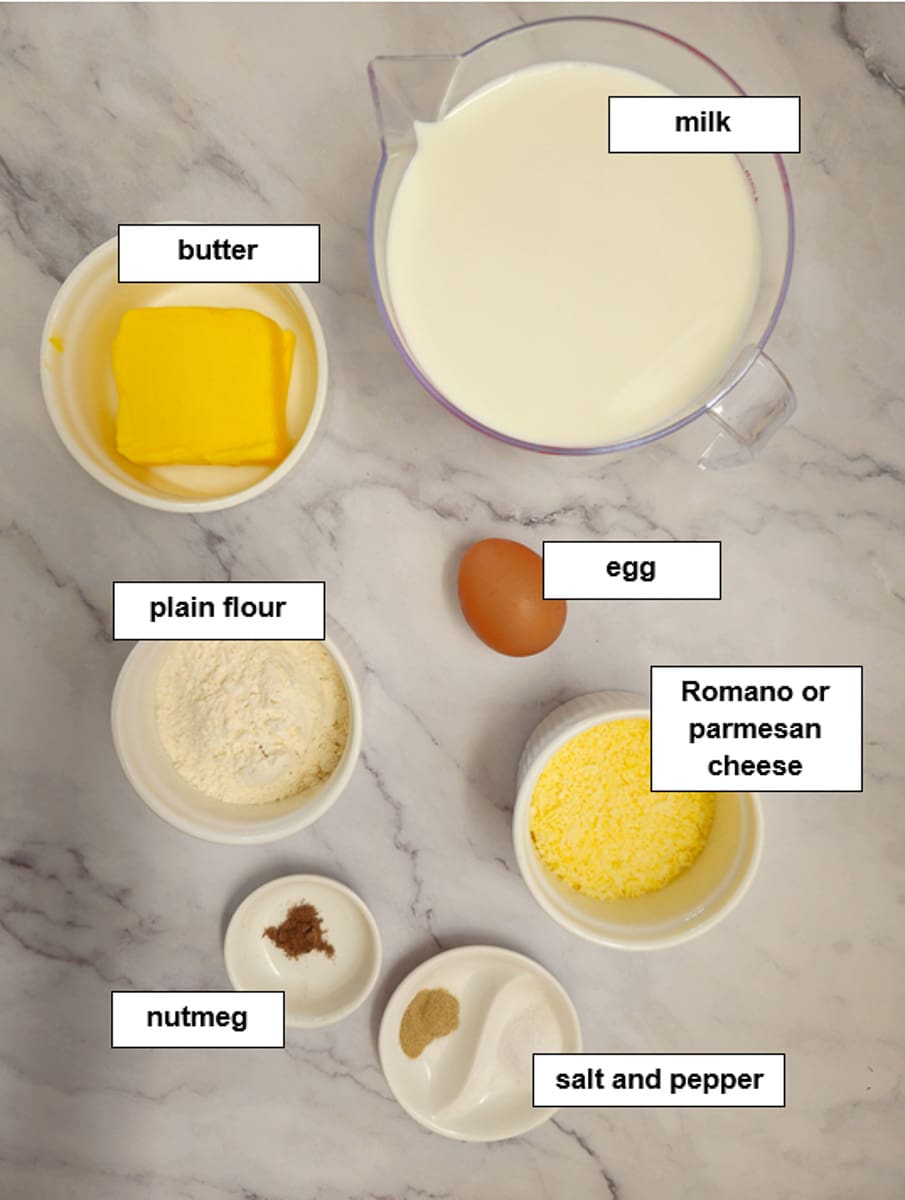
- Milk: I usually use lite white milk as this is what I tend to have in the fridge, but whole milk or plant-based substitutes like oat or soy milk can be used, depending on personal preference.
- Romano or Parmesan cheese: Romano or Parmesan cheese is stirred through the béchamel sauce and sprinkled over the béchamel layer for a golden, cheesy finish. I prefer to use Romano cheese in pastitsio for its sharper flavour, but you can substitute it with Parmesan cheese for a similar depth of flavour with a slightly milder taste.
- Egg: Egg helps to bind the sauce together making it easier to slice into neat portions once cooked.
How to make the béchamel sauce

1. Warm milk in the microwave for 1 minute.
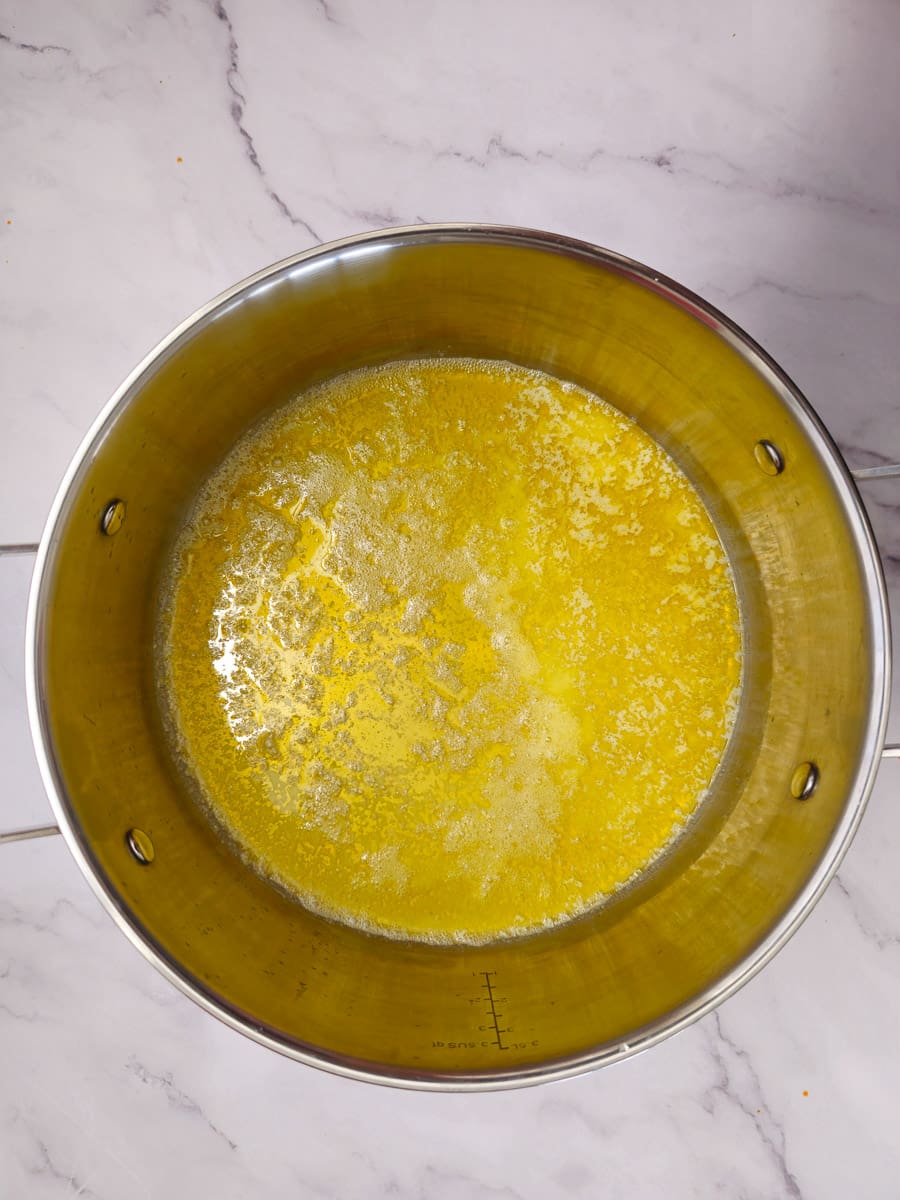
2. Melt the butter in a large saucepan over medium heat.
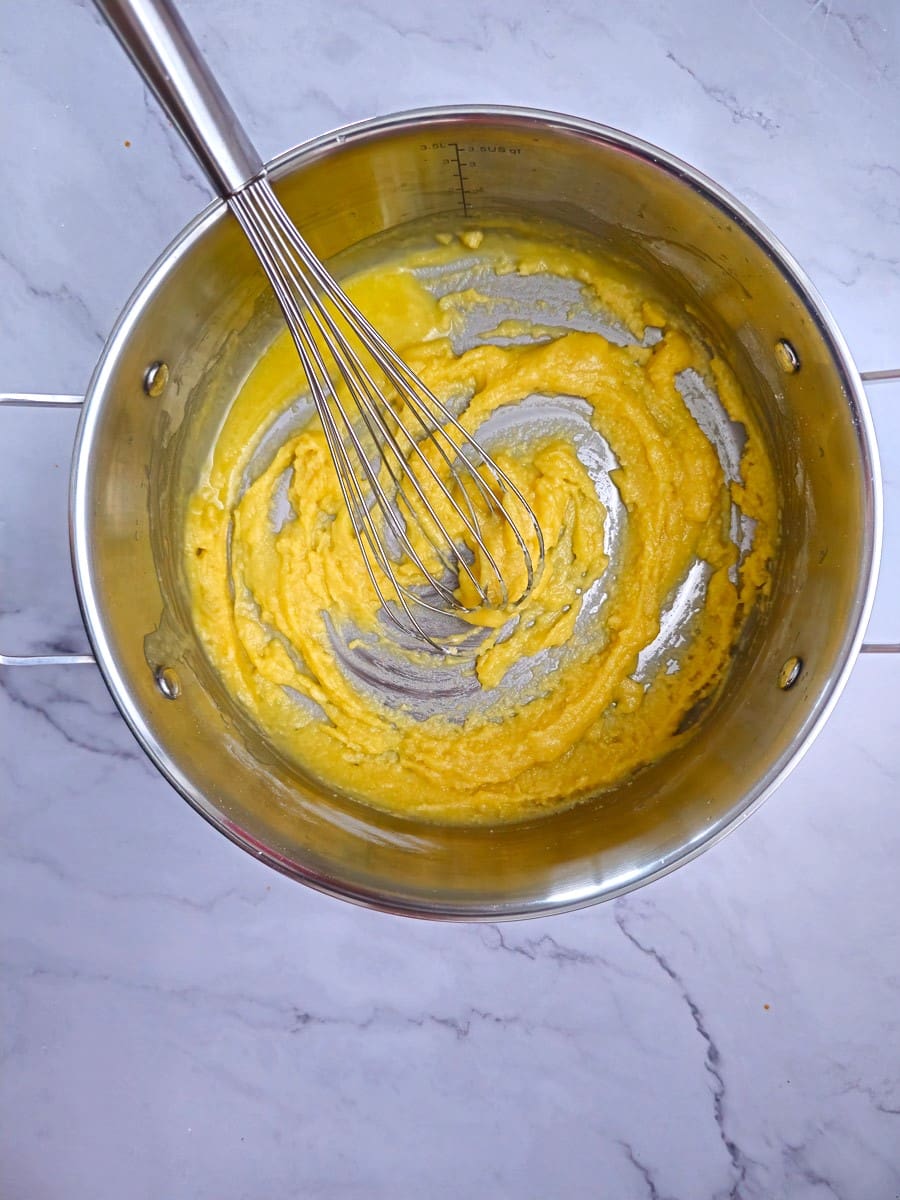
3. Add the flour, whisking continuously to make a paste. Stir for 1-2 minutes.
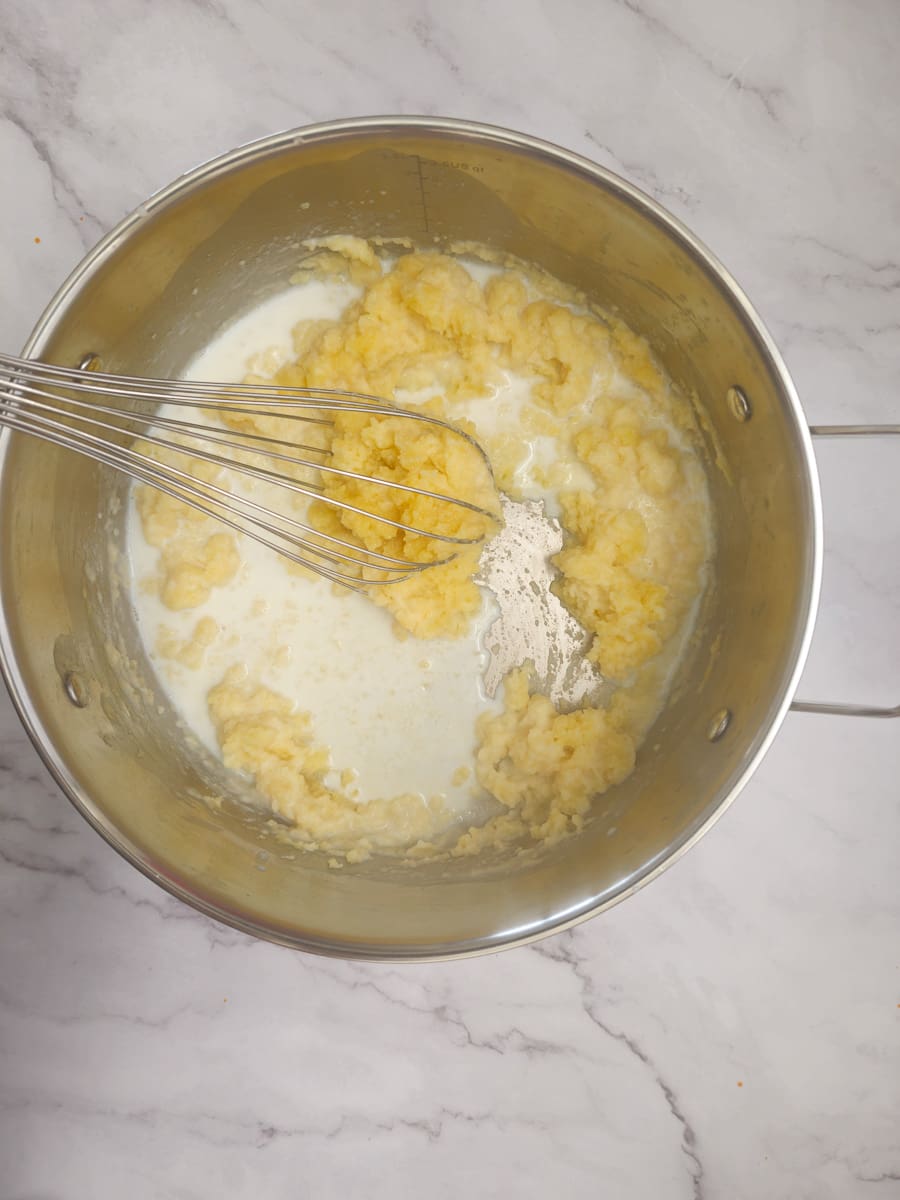
4. Gradually add warm milk, whisking continuously after each addition to prevent your sauce getting lumpy and sticking to the bottom of the saucepan.
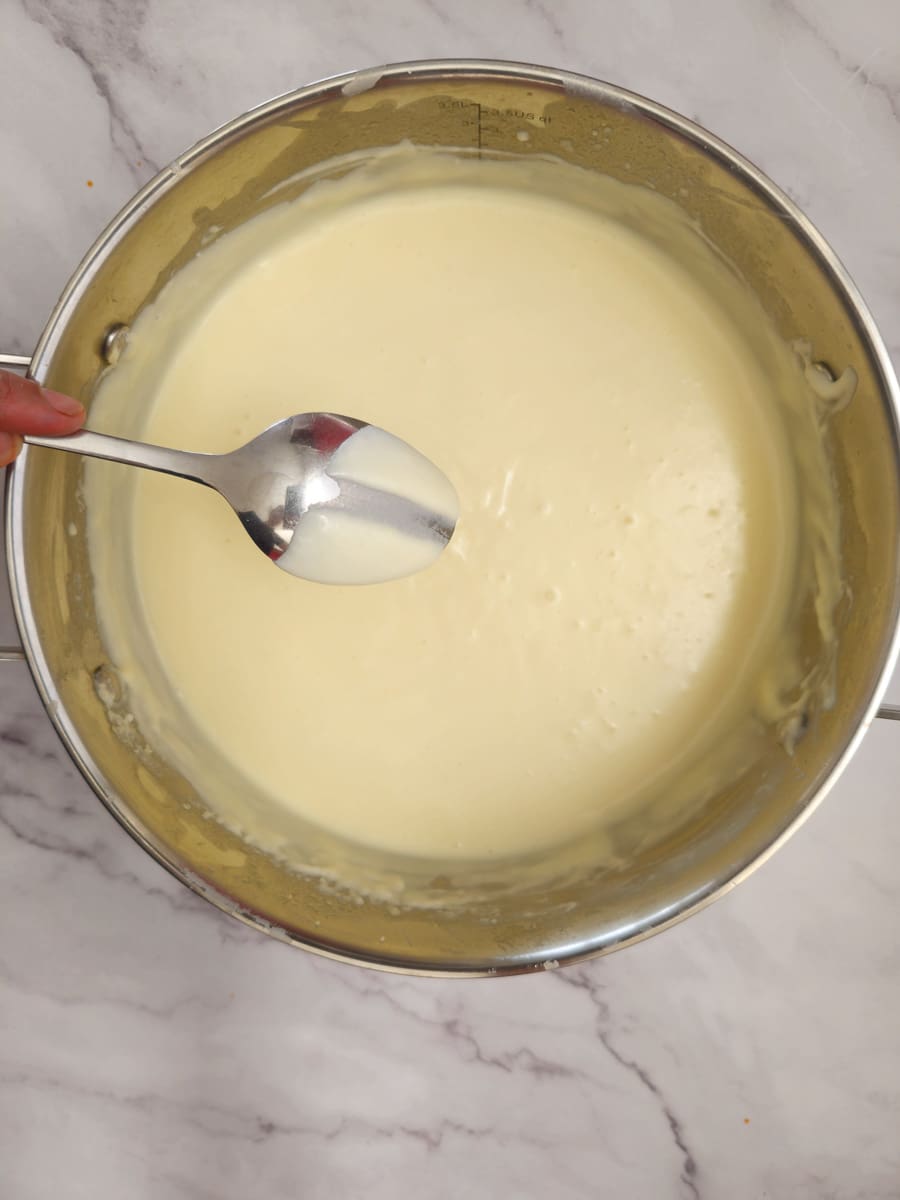
5. Once all the milk has been added, continue whisking over medium heat until the mixture is thick and coats the back of a spoon.

6. When ready, remove from the heat and stir through salt, pepper, nutmeg and cheese. Cool slightly and then whisk through 1 whole egg.
Assemble and bake
When assembling this Moussaka, there are 6 layers:
- Bottom layer: Potatoes.
- Second layer: Eggplant.
- Third layer: Meat sauce.
- Fourth layer: Any leftover eggplant.
- Fifth layer: Any leftover potatoes.
- Top layer: Béchamel sauce topped with grated cheese.
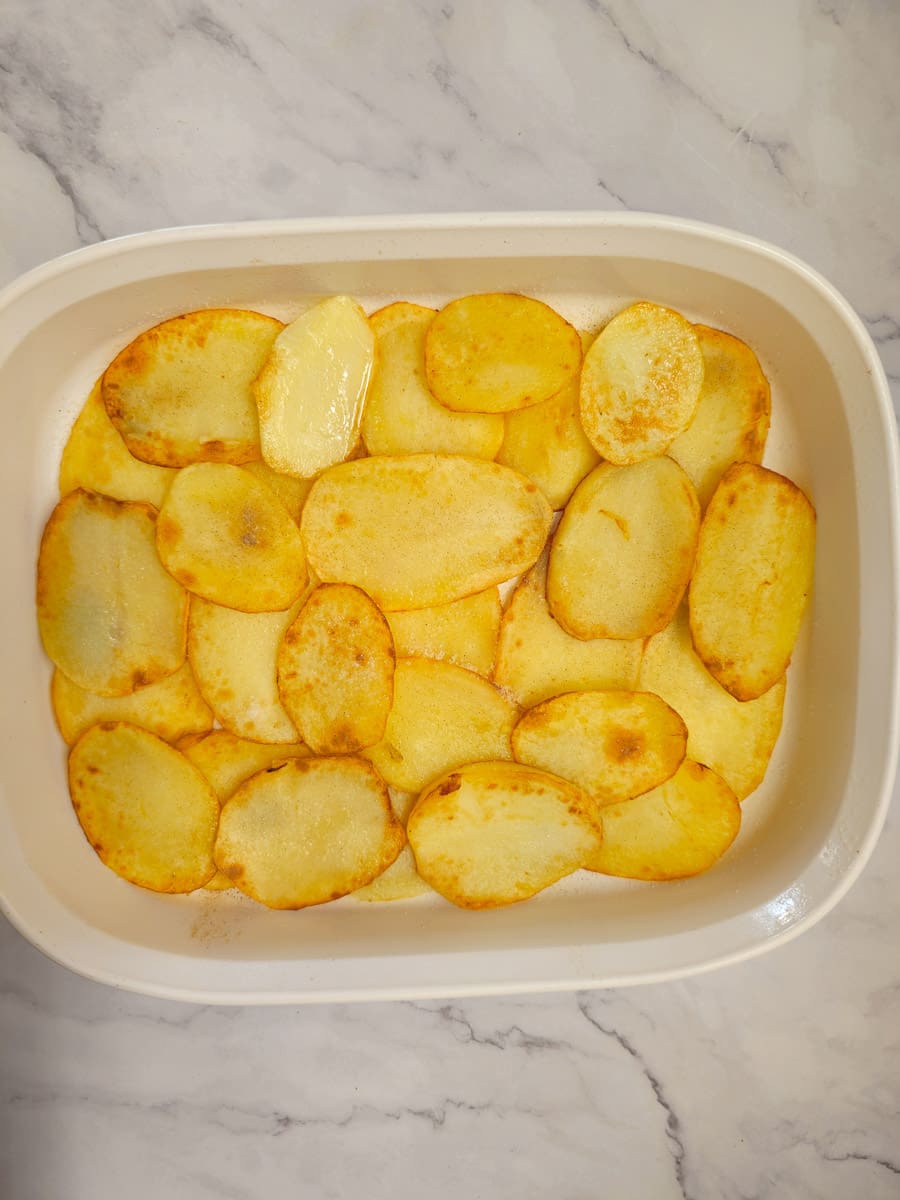
1. Lightly grease baking dish. Arrange 2/3 of the potatoes across the bottom of the dish. Overlap them to fill any gaps.
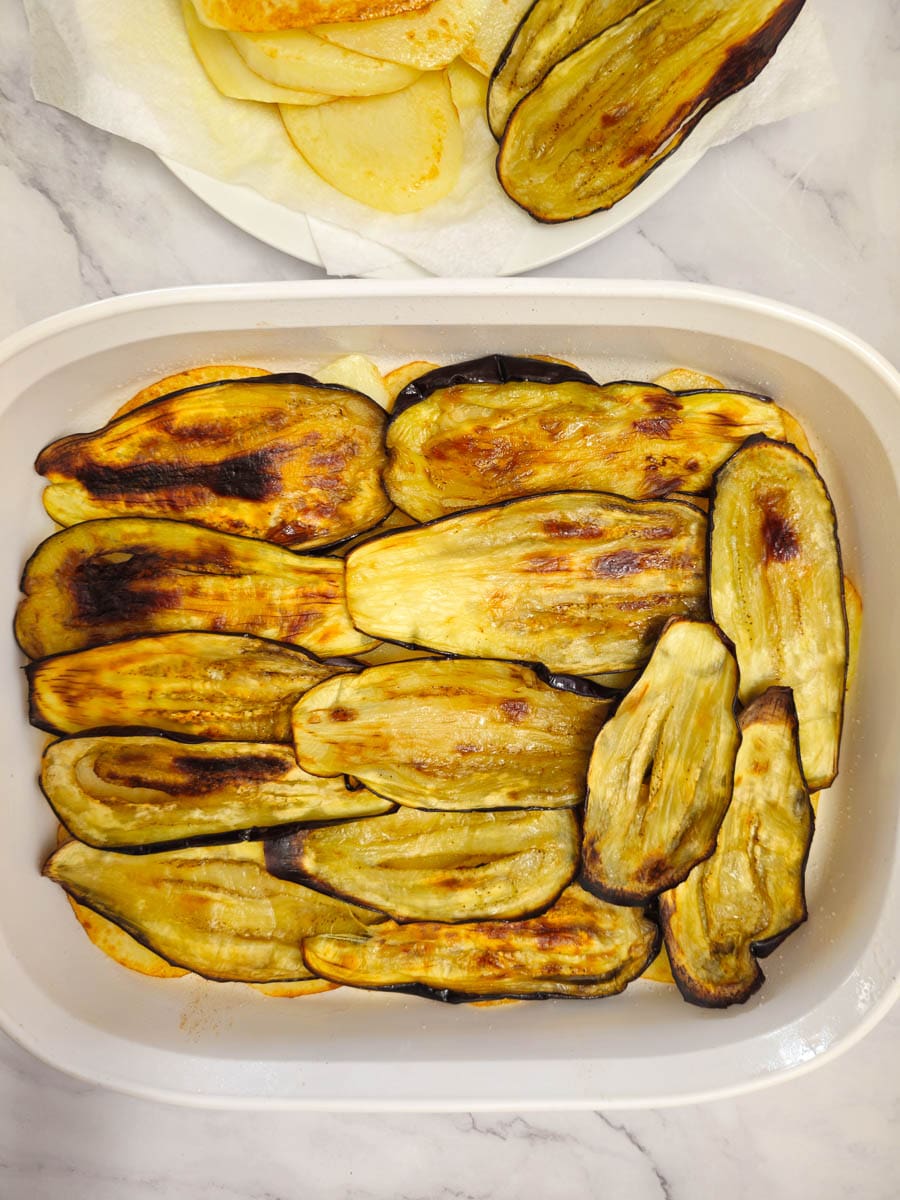
2. Arrange one layer of sliced eggplants on top of potatoes.
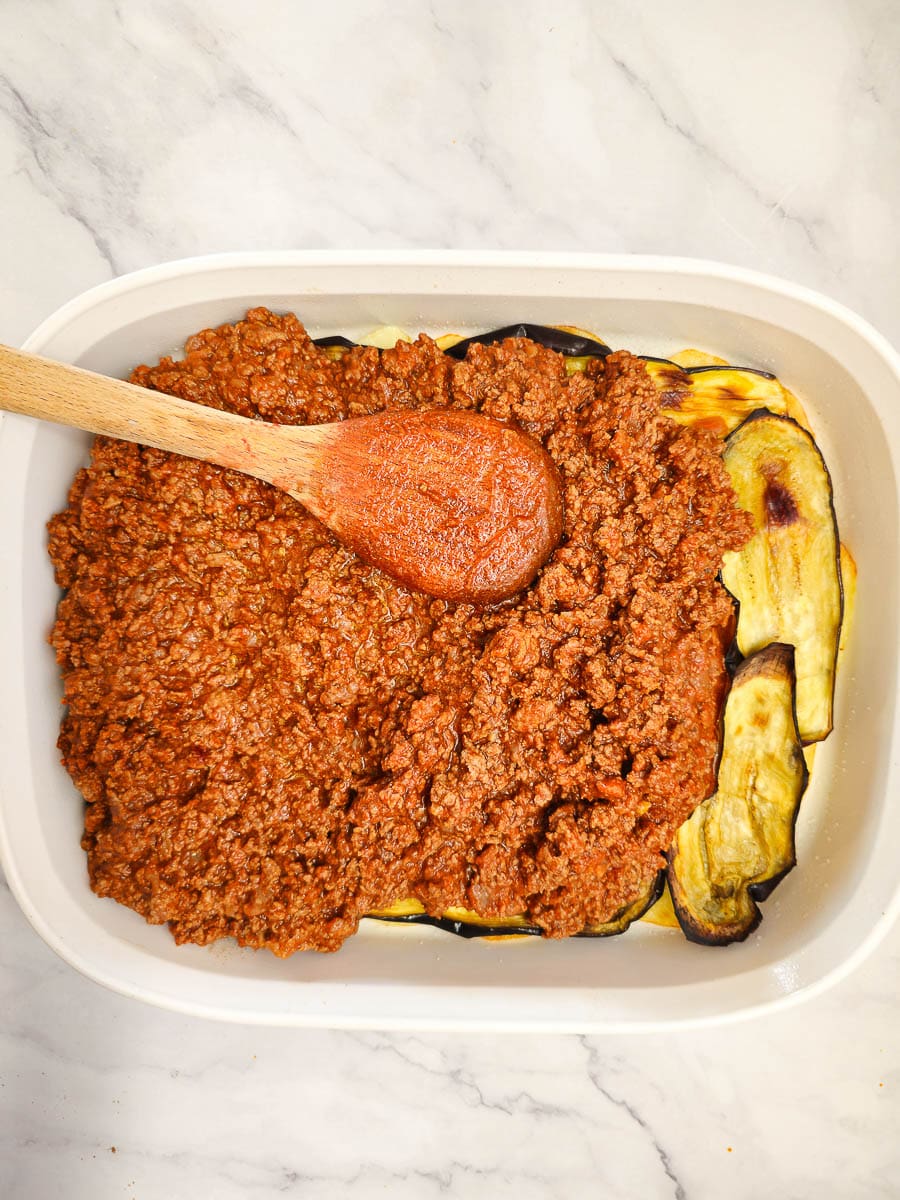
3. Spread all of the meat sauce over the eggplant layer.
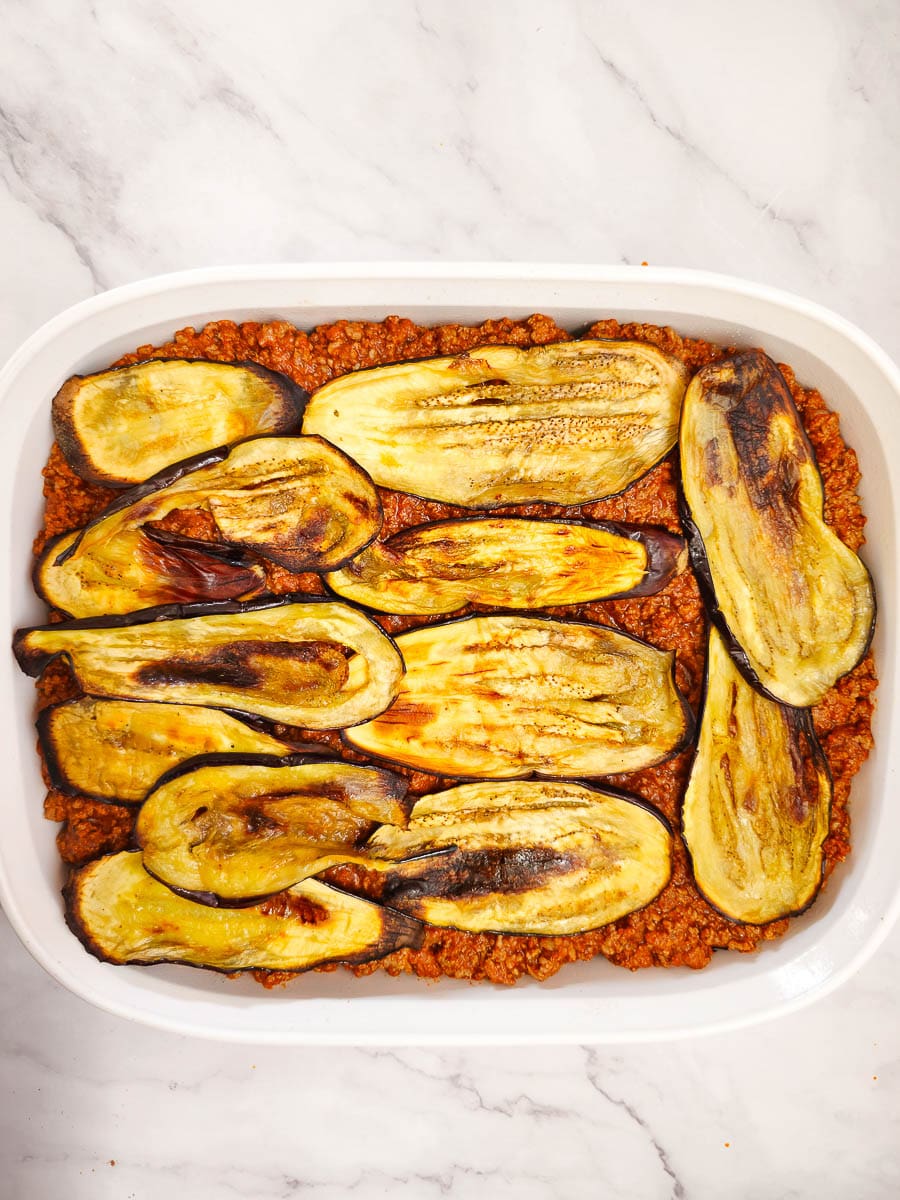
4. Arrange another layer of eggplant over the meat sauce.
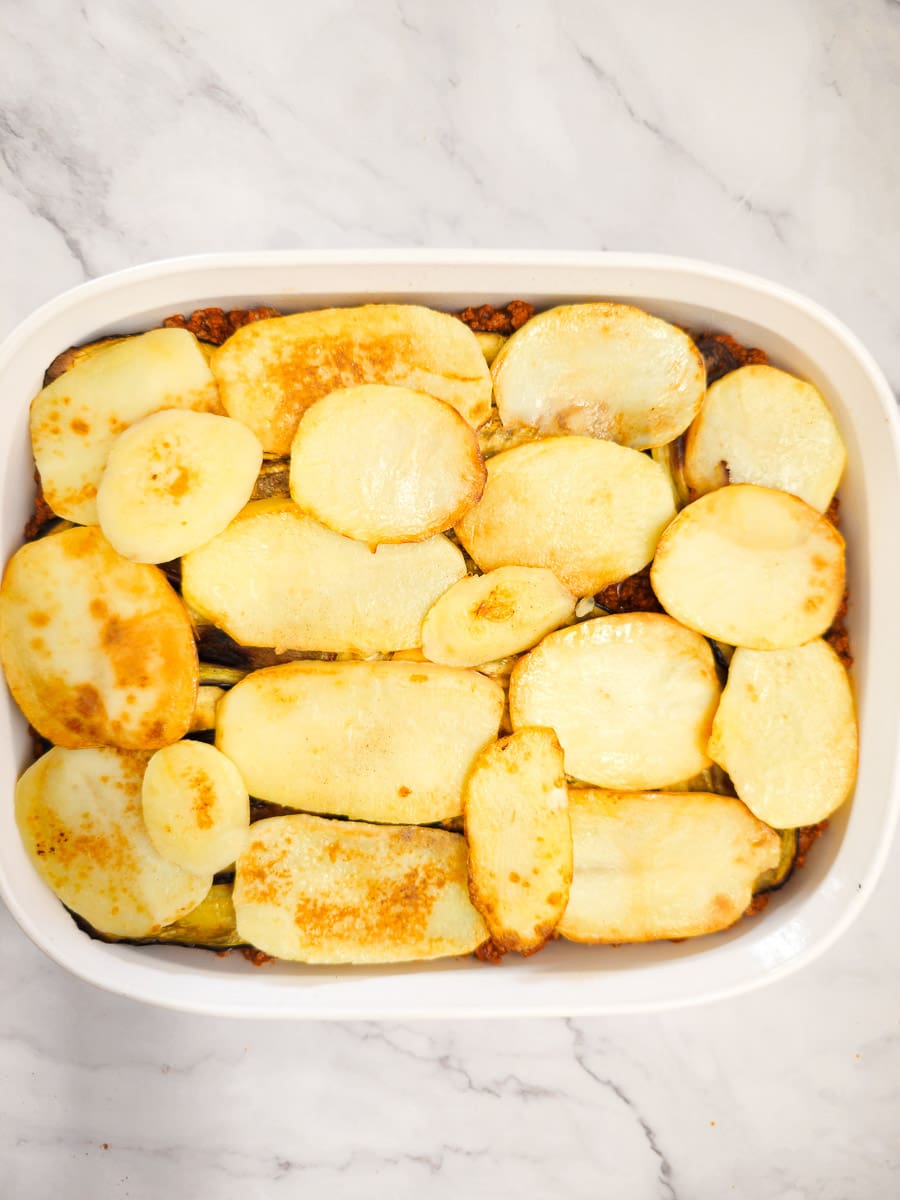
5. Layer remaining potatoes on top of the eggplant.
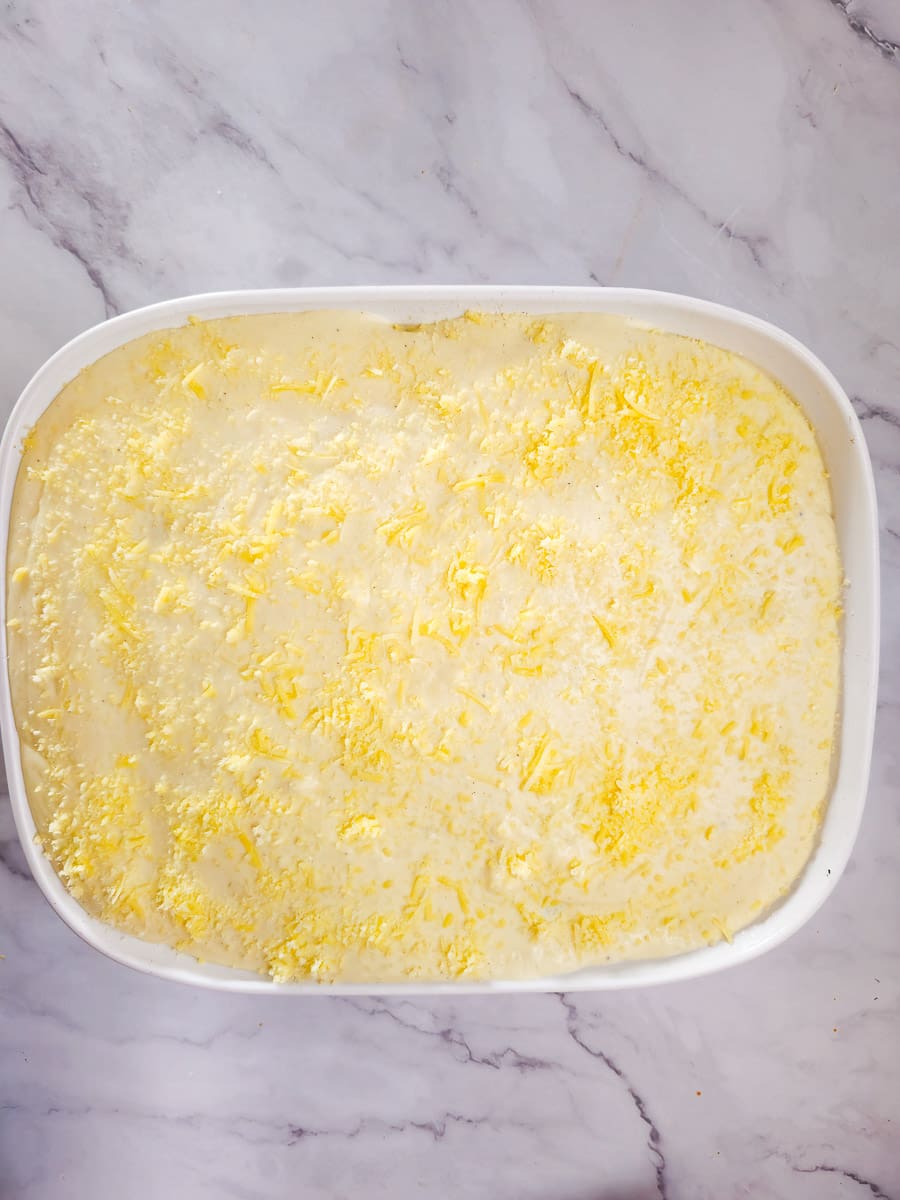
6. Pour béchamel over the top and sprinkle with Romano/Parmesan cheese.
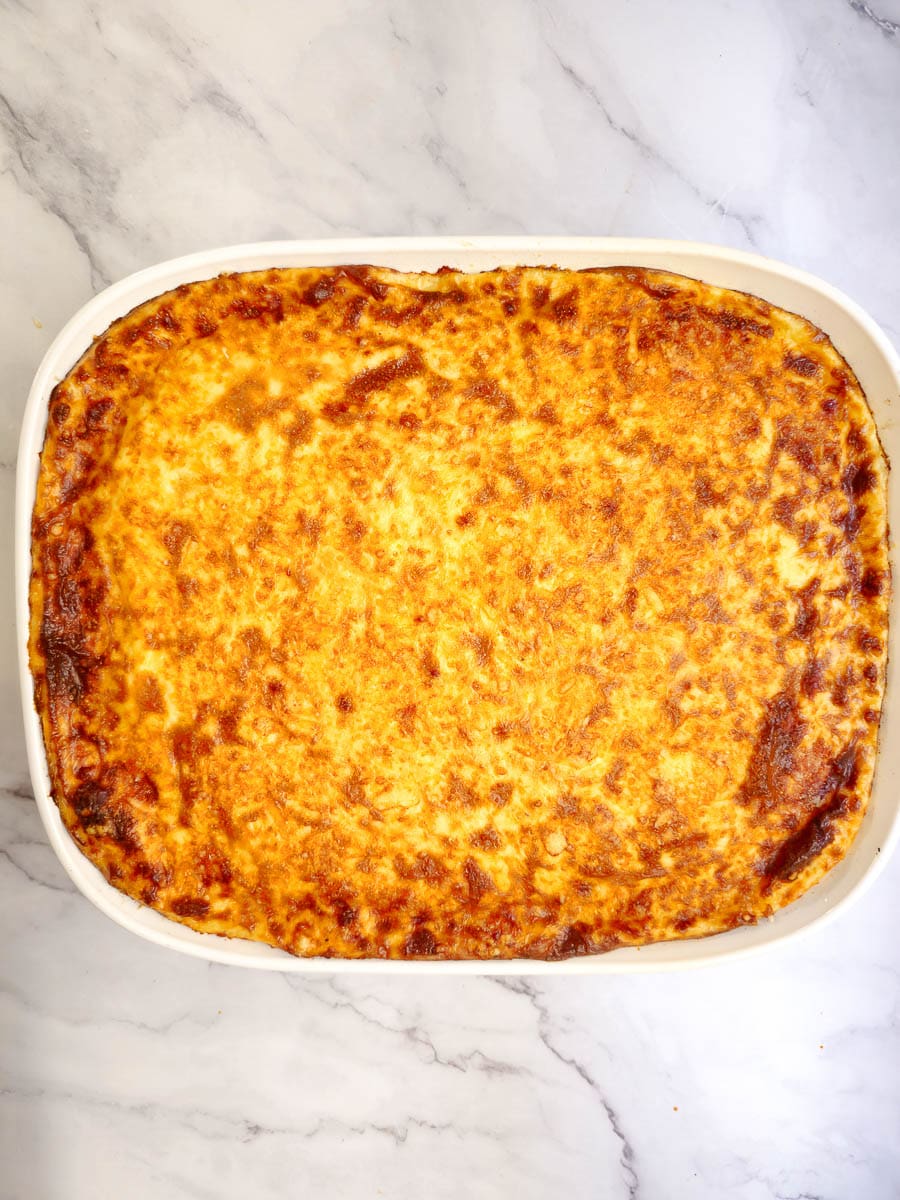
7. Bake Moussaka. Set the tray on the middle rack in a moderate oven at 180°C/350°F, for approximately 40-45 minutes or until golden.
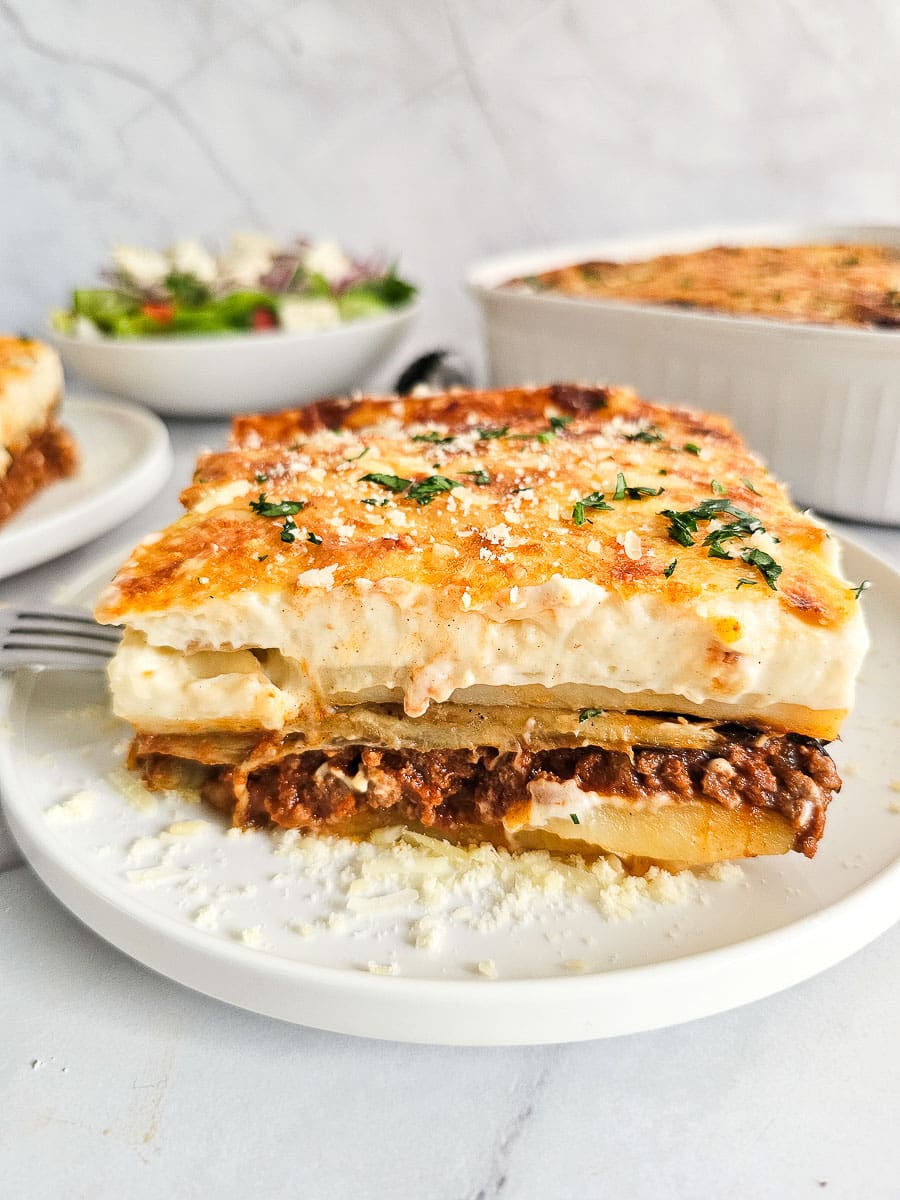
8. Remove from oven and rest for 20 minutes so it sets before slicing into squares.
What to serve with Moussaka
Moussaka pairs well with a refreshing Greek Salad or Greek Lettuce Salad – Maroulosalata. The salad complements the richness of the Moussaka perfectly and creates a well-balanced meal.
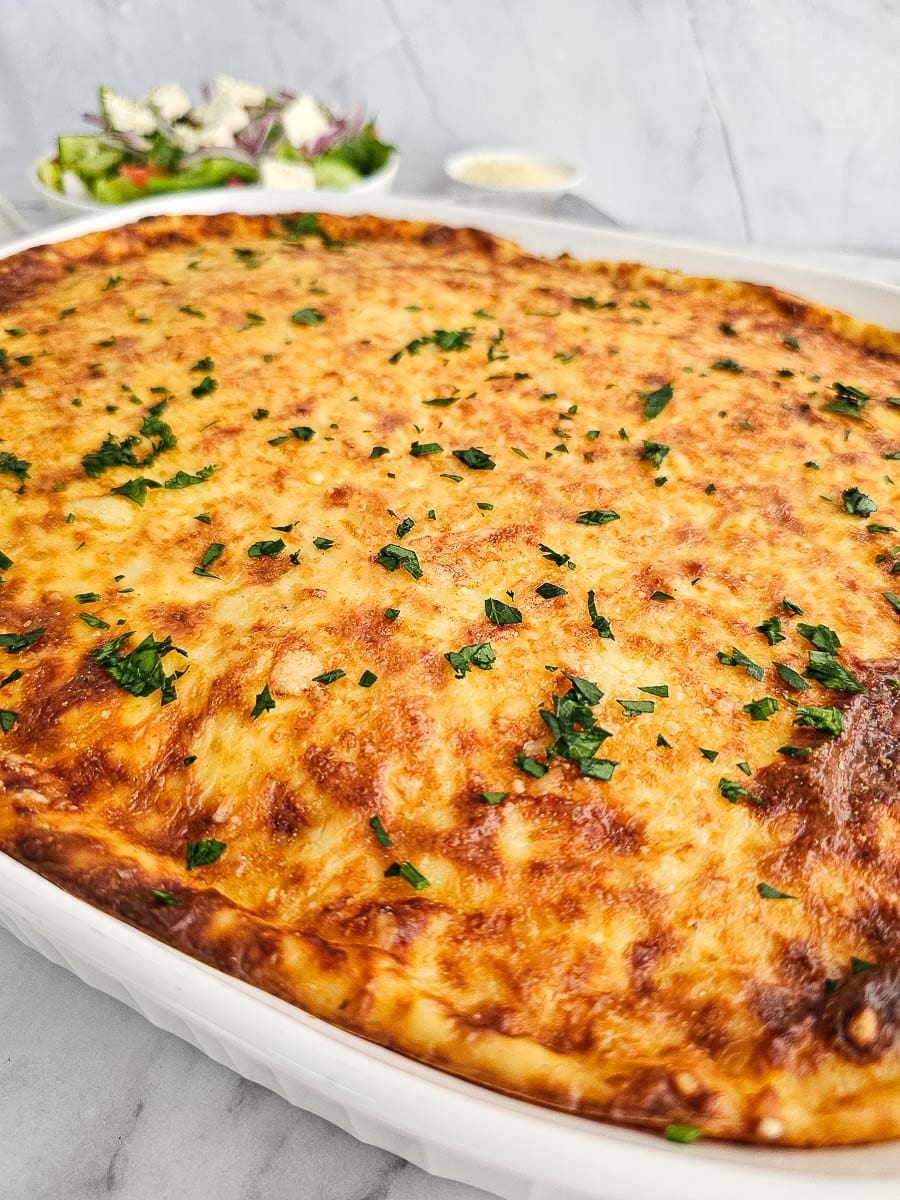
Health benefits of Moussaka
Moussaka offers a variety of health benefits. The eggplant is rich in antioxidants, fibre and vitamins, promoting heart health and aiding digestion. Lean ground beef provides protein for muscle maintenance and repair, while tomatoes contribute lycopene, a powerful antioxidant known for its cancer-fighting properties. The inclusion of potatoes in Moussaka contributes essential nutrients like potassium, vitamin C and dietary fibre, promoting heart health, supporting immune function and aiding digestion. Additionally, the milk used in the béchamel sauce provides calcium for bone health and protein for muscle growth and repair.
Tips for making Moussaka (Minced Beef, Eggplant and Potato Bake)
Do you need to salt your eggplant?
Salting and sweating the eggplant slices helps remove excess moisture, resulting in a firmer texture and preventing the dish from becoming watery. To salt the eggplant, arrange slices in a colander, generously sprinkle with salt, and allow them to sweat for about 30 minutes. Rinse and pat dry before using.
Why is my Moussaka watery?
There are several possible reasons why your Moussaka may turn out watery:
- Excess Moisture in Ingredients: Eggplant, being the primary vegetable in Moussaka, tends to release moisture when cooked. To prevent this, you can try salting the eggplant slices and letting them sit for a while before cooking to draw out excess moisture. Additionally, make sure to drain any excess liquid from cooked vegetables, such as tomatoes, before layering them in the dish.
- Sauce Consistency: The meat sauce and béchamel sauce should have a thick consistency to prevent excess moisture from seeping into the layers. If your sauces are too thin, they may contribute to a watery Moussaka. You can thicken the sauces by simmering them for a longer time or adding a thickening agent like cornstarch or arrowroot powder.
How to make this Moussaka recipe gluten-free
To make this Moussaka recipe gluten-free, you’ll need to replace the wheat-based ingredients with suitable alternatives.
- Flour in Béchamel Sauce: Instead of wheat flour, you can use a gluten-free flour blend. A combination of rice flour, tapioca flour and potato starch in equal parts can work well. You might need to adjust the quantity slightly, as gluten-free flours can behave differently.
- Beef Stock/Bouillon Cube: Some beef stock cubes contain gluten as a binder. Look for certified gluten-free beef stock or bouillon cubes.
How to make this Moussaka dairy-free
To make this Moussaka dairy-free, you’ll need to replace the dairy-based béchamel ingredients with suitable alternatives.
- Replace the butter with dairy-free margarine or coconut oil.
- Substitute the milk with a non-dairy milk alternative such as almond milk, soy milk or oat milk. Use unsweetened varieties for savoury dishes.
- Substitute the cheese topping with a dairy-free cheese alternative, such as a plant-based Parmesan cheese, or substitute with nutritional yeast instead.
You may prefer to just follow the Vegan Béchamel recipe steps in my Vegan Moussaka recipe.
Resting time
Be sure to let the Moussaka rest for at least 20 minutes after baking to allow the flavours to blend and for excess moisture to redistribute. Allowing it time to set also makes it easier to slice and serve. So, while it may be tempting to dig in right away, allowing your Moussaka to rest will greatly improve its texture and flavour.
To prepare ahead of time
To prepare Moussaka ahead of time, prepare the vegetables and meat sauce the day before. On the day of baking, make the béchamel sauce, assemble the Moussaka and bake. Alternatively, you can prepare the whole dish in advance and simply bake it on the day you plan to serve it. Just refrigerate the assembled Moussaka, then pop it in the oven when you’re ready to bake and enjoy. If you are using a ceramic or glass baking dish, ensure that you have allowed enough time for the baking dish to cool down before baking, as these materials can crack if exposed to rapid temperature changes. To prevent this, I place the baking dish in the oven while the oven preheats. Another option is to use a metal baking dish, which is less likely to crack due to temperature changes.
Storage
This recipe serves eight, so it’s perfect for dinner for two nights or as a lunch. If you enjoy having leftovers, this means you can take a break from cooking for one evening. Leftovers can be stored in the refrigerator for 4-5 days or frozen for up to 3 months. To reheat, thaw overnight in the fridge and warm in a moderate oven or microwave until heated through.


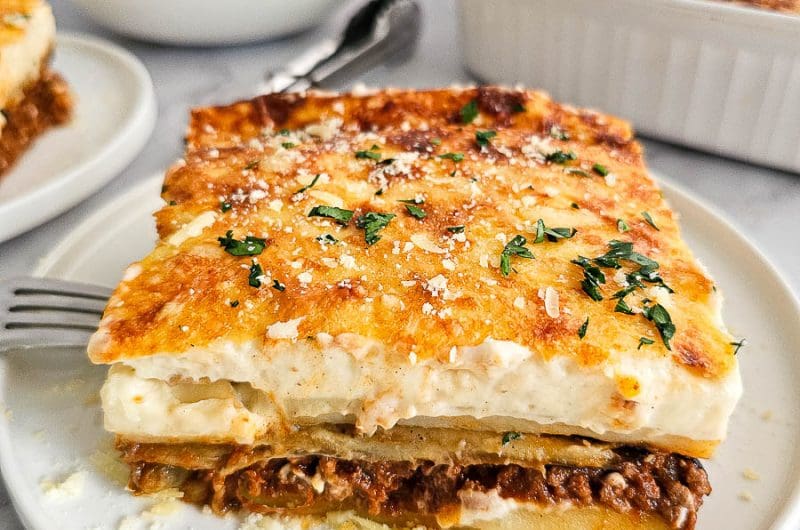
Thank you for the incredibly well presented recipe. The detail of instructions on ingredients and techniques is outstanding and makes me confident that when I prepare this dish it will taste as wonderful as I imagine. My tastebuds are already dancing in anticipation!
Hi Stevie, thank you so much for your thoughtful and wonderful comment. You have made my day! All the very best, Chrissie.